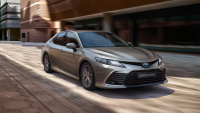According to last year's results, Toyota is the undisputed leader in Segment D in terms of the number of cars sold: 30,136 sold Camry - four times more than its closest competitor Hyundai i40 (7,174 units)! Kia Optima, by the way, was sold less (3096 pcs.). The situation should be corrected by the new model, which appeared at the end of 2015. And the buyers are enticed by "two-faced" character of the novelty: say, if you want a comfortable business car - buy a regular Optima, but if your soul demands excitement, choose the 240-horsepower Optima GT or at least a less powerful sedan with a dodger GT-line. The last one just came to us for a test.
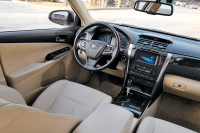
Exactly sports trimming without funny "three-barrelled" light-emitting diode foglights, makes Kia similar to exited earlier Camry. Outwardly, snow-white sedans really resemble each other, especially from the opposite side: slanted headlights united by a radiator grill, triangles of side and trapeze of the central air inlets, developed aerodynamic flashes on corners of bumpers ... It is difficult to tell it apart from 30 meters! However, a younger model of Korean brand looks more modern and more stylish - after all, Optima is not an updated model, but almost completely new. The seventh generation Camry, updated back in late 2014, came out in 2011. Kia also looks bigger than its direct competitor, although in fact it almost repeats the dimensions of Camry: it is 35 mm wider, 5 mm higher and the same amount longer.
Kia Optima vs Toyota Camry. The optimum balance
Design of modern Kia never ceases to please: both statically and dynamically, the Optima is extremely effective
Despite the age, as we have already mentioned, the position of Japanese sedan does not surrender. It also concerns the price policy: presented in the test Camry with atmospheric engine 2,5L and automatic, though a little bit more expensive than Kia with a comparable power unit, but it is equipped noticeably worse. Curl your fingers: panoramic roof, ventilation of front seats, automatic unlocking of a trunk, all-around vision camera, navigation system, advance parking assistant, rear door sunblinds, bi-xenon headlights, electronic handbrake ... All this riches Japanese rival is deprived. Moreover, Kia meets its passengers in the dark with illumination, hidden in door handles. Immediately it disposes to itself! What does Toyota offers instead? Let's try to understand.
If the theater begins with a hanger, so acquaintance with the automobile - from a driving seat. Plunging into interior of Kia, you catch yourself at the thought that it reminds you something... Earlier Korean cars were closer to Japanese, but now it is an obvious orientation towards Germans, namely Volkswagen and Audi. And it is not parody or imitation, but more likely the same spirit: verified ergonomics, quiet geometrical forms and absence of "shouting" details.
Armchairs are set low, have the developed support, a small diameter of a steering wheel has a slanted in sports manner bottom edge, the central console is a little bit turned to the pilot. Restrained, but persistent hint of excitement! As a whole, I liked the seat behind a steering wheel, but the profile of seats though in combat style is tight, but not adjusted up to the end, and even in the lowest position of a pillow the ceiling visually "presses" a little: at my height of 179 sm a free clearance above my head did not exceed 5-7 sm.
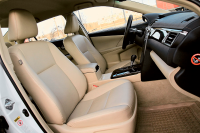
On the move the Toyota is rather bumpy, but "softly slopes" and pleases with power-consuming suspension.
The Camry has a totally different, unchanged over the years mood: here, as before, comfort and proven solutions rule the roost. The design of the dashboard was already outdated at the stage of updating in 2014, and plastic and wood inserts were probably criticized only by lazybones... But, perhaps, there is nothing absolutely bad in it. I'm sure, the older target audience will definitely appreciate the conservative interior, where everything is familiar and clear. Older generation will choose "Toyota" also for other quite clear reasons: a person both taller and bigger can sit down imposingly behind a helm here - there is room to spare in all directions. Especially easy to sit in the back: the Camry in terms of space on the second row among the competitors - a real limousine! In Kia, of course, is not so spacious, but it is not tight, and in addition to the air vents, there are curtains on the windows, a cigarette lighter jack and a USB-port for charging gadgets at the disposal of passengers.
Rather soft seats of Toyota do not dispose to active driving - there is lack of side support, and leather is slippery, but their profile is more successful. Also here is much better visibility, than in coupe "Optima": due to higher seating one feels dimensions of the automobile sharper both in front, and on sides - basically one does not need any all-round visibility. Though Kia has the latter option, but apparently it is "for show": the quality of the image leaves much to be desired. Peculiarities of the review are distinctly noticeable while driving into underground parking place: if with Kia you take precautions and drive in two rounds just in case, with Toyota you get in from the first time, without even thinking.
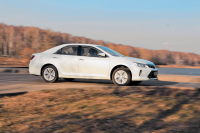
In motion the cars also have absolutely different characters. Kia's suspension turned out to be surprisingly well-balanced, which was not observed for Korean cars before: despite of 18-inch wheels, all road trifles are perfectly isolated from interior, on asphalt waves there is no strong swaying, and at maneuvers the sedan behaves quite stable, almost not pestering with rolls. Toyota is much more wobbly in turns, but its suspension would suit a crossover as well - power capacity is up to the mark! In terms of directional stability both sedans are good, but only in the Camry had to make allowance for studded tires, which at zero temperature made the behavior of the sedan excessively smeared. The Optima enters corners much more willingly, but the effort on a steering wheel is too artificial, though with sharpness everything is all right. There are also claims to Toyota in this respect - steering wheel lacks information value and quick reactions, but one gets used to it in both cases.
But from the point of view of acceleration dynamics the priority is passed to "Toyota". In spite of the fact that automobiles are very similar under the passport characteristics (acceleration up to a hundred makes 9-9,1 seconds), Toyota engine is perceived much more lively: Camry is accelerated both from a place and from speed much more readily, despite of more thoughtful automatic device. May be the reason is in Japanese engine less strangled by Euro norms, and maybe - in more conservative injection system: unlike direct at Kia, Camry's engine is "distributed". It is an additional plus to Japanese reliability - the simpler fuel system, as a rule, is more live with our fuel and is easier to maintain.
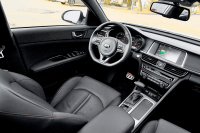
Speaking about maintenance, we should mention the cost of possession. It is cheaper to maintain Korean sedan: the cost of a Casco, for example, in Kia is almost by 40 thousand less, and to conduct scheduled comparable to cost maintenance is 1,5 times less - every 15 thousand km. However, there is an opposite side of the medal: Camry keeps better residual value, and shorter maintenance intervals, as experience shows, often become the key to that very reliability. So far, the argument in the form of the Camry's higher liquidity has been the deciding factor, as the sales figures eloquently illustrate. Time will tell if the market situation will change with the arrival of such strong contenders as the Optima.
KIA OPTIMA
According to many parameters, Korean Optima will handicap the Japanese: its character became much more balanced.


-rear-and-front-view-camera-6.png)
